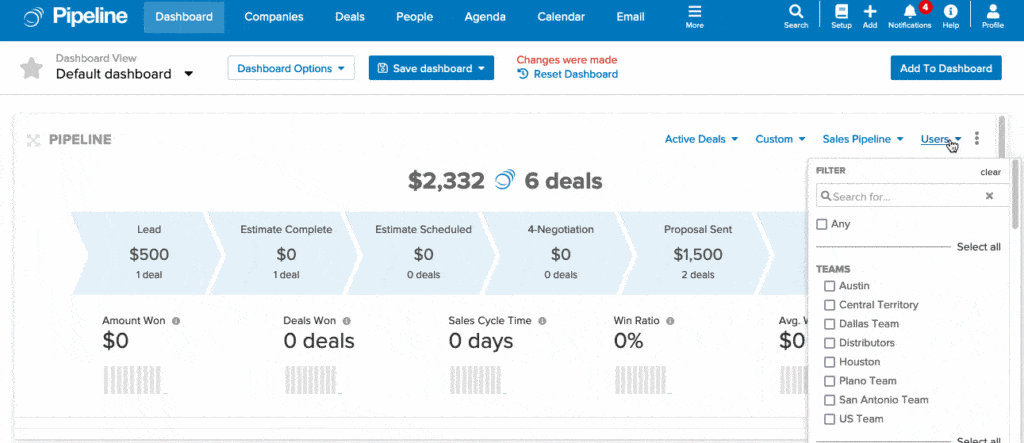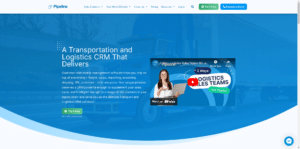Prospecting continues to change.
According to Forrester, 90% of the buyer’s journey is complete before they speak with your sales team.
How? Why? Well, when prospects hit your inbox, they’re looking for the best candidates to fit their budget and research criteria. These prospects have probably spent a significant amount of time educating themselves on their needs. They have a list of capabilities or requirements, and they want to see which company meets their criteria.
Do you know what’s on their list (most companies don’t)?
Sales Funnels vs. Sales Pipelines: What’s the Difference?
The terms sales funnels and sales pipelines are often used interchangeably as if they’re discussing the same thing.
That’s a mistake because they’re referring to two different things.
Let’s take a look.
- Sales pipelines are internally focused: a pipeline tracks seller performance; it provides a visual cue, outlining where each prospect is in the sales process (e.g., prospecting, qualification, offer, negotiation, closing). Your pipeline tells sellers (you) about the specific to-dos your team will need to close each prospect. A pipeline report tells you about the number of leads in your pipeline and the value of these leads.
- Sales funnels are externally focused: your funnel measures customer response. Your funnel focuses on the specifics and activity of each prospect and the group. Sales funnels typically have five to seven stages – awareness, interest, desire, evaluation, and decision. Your sales funnel is an assessment tool you can use to forecast sales, identify funnel failure points and improve sales processes. If you lose 25% of your prospects in the evaluation stage, this is a sign that you’ll need to improve things internally to meet your prospect’s evaluation criteria.
Here’s a brief comparison of the two.
| Sales Pipeline | Company Goal | Sales Funnel | Prospect Perception |
| Prospecting | Finding Ideal Prospects | Awareness | A Viable Option |
| Qualification | Willing and Able to Buy | Interest | Quality Candidate |
| Offer | Asymmetrical Value | Desire | Value Gained at a Bargain |
| Negotiation | Win/Win | Evaluation | Low Risk/High-Value |
| Closing | Profit | Decision | Best Value for Money |
| Repeat sales | Increased CLTV | Loyalty | Trust Relationship |
Can you see the parallels? Your sales pipeline is internally focused, while your funnel is externally focused.
Because of the difference, it becomes a problem for many organizations as they don’t have the tools and resources needed to evaluate their performance in these two tracks. As a result, their results tend to plateau over time. However, if we look at data-driven sales teams that do have the tools such as CRM systems, we see they outperform their average competitors by 23x.
By looking at the chart above, you will see how to approach prospects at each stage of the process. It guides you on how to speak to your prospects, what your messaging should be throughout the sales process, and how to align your sales reps and your prospects.
Now that you know the difference, learn how to create powerful templates that amplify closing abilities.
Creating Powerful Sales Funnel Templates
Remember the criteria from our chart above?
- Awareness: your company is a viable option for prospects. It’s a possibility that’s open for consideration, and that’s the starting point.
- Interest: you position yourself as a quality candidate that provides the value prospects are looking for.
- Desire: you’ve presented prospects with an irresistible offer that incentivizes your offer, motivating prospects to purchase your product or service.
- Evaluation: your prospects have a specific list of criteria. They want to see that you have: (a.) An intuitive understanding of who they are and what they want. (b.) A comprehensive understanding of their problem and the things that delight them. (c.) A clearly defined and effective solution to their problem. (d.) Answers to their objections (e.) the ability to take on or eliminate the risks to them. (f.) A strong portfolio of reviews and testimonials referencing your product or service.
- Decision: if you’ve met the criteria above, and you’ve passed with flying colors, there’s a very good chance your prospects will make the decision to buy.
- Loyalty: your prospects will be satisfied. What does this mean? If it ain’t broke, don’t fix it. If you consistently produce results or outcomes for your prospects, they’re far more likely to display loyalty.
Let’s look at how we create email broadcast/autoresponder sequences and templates that take prospects through the buyer’s journey.
First, we’ll start with funnel sequences.
Awareness emails
These are two to three emails that answer three important prospect questions:
- Welcome emails: who are you? What makes you credible? Why do I need you? What should I expect from you? At this point, your prospects are excited to hear from you.
- Indoctrination emails: what kind of exclusive value do you provide? Create curiosity loops that motivate prospects to click on your messages and content and ask for micro-commitments (like, follow, subscribe, etc.)
- Priming emails: these emails train your prospects to watch for your messages (i.e., I’ve got a gift for you in my next email). These emails orient your prospect’s awareness around your content and offers.
Here’s an example template:
Industry: Wholesale
Subject: We’re on a mission to double the revenue of your retail storefront
Body:
Hello there [Name]!
I’m so glad you made it.
Thanks for sharing your time with us, I want to ensure we’re upfront about what you’re getting into. 😉
Who are we?
We’re Wholesale Plus, a small, scrappy team of retail experts who want to help your small businesses compete and win against big box stores like Walmart, Amazon, and Target.
We’ve helped 53,000 small businesses just like yours source their next bestseller.
Why do you need Wholesale Plus?
Small businesses that work with Wholesale Plus see a 32% increase in revenue in their first year. From there, we want to help you double the revenue of your retail storefront. We’ll send you in-depth guides covering a specific area of your business once each week.
Each guide will come with a cheat sheet or tool you can use to get an immediate win.
That starts tomorrow.
Today I have a gift for you. It’s a guide you can use to negotiate better deals with wholesalers like us. Yes, we’re acting against our self-interest.
Download it here.
Landing page:
Businesses that work with Wholesale Plus see a 32% increase in revenue.
Sixty-three percent of these businesses double their revenue within 36 months. How do they achieve these dramatic increases in revenue? They pull on one of these four profit levers. —>
Download our wholesaler negotiation guide, and we’ll show you how to get immediate gains in your retail business.
Get the Guide
Interest emails
These emails are designed to build interest, creating a desire for your offer.
- Problem emails: these emails outline the problem, unpack why these problems are a problem, and explain the inevitable consequences that appear if the problem is ignored.
- Solution criteria emails: these messages train prospects, showing them what solution is best.
- Solution emails: if you want prospects to accept your solution, it needs to mirror the problem. It needs to provide prospects with closure; their problem is fixed for good.
Here’s an example template:
Industry: Manufacturing
Subject: If you purchased [product], you may lose $953K
Body:
[Name],
Can your manufacturing small business afford to lose [$953K]?
If your manufacturing firm has the JMT horizontal band saw, you’re in a tough spot.
That decision may cost you.
Is that because JMT makes inferior products? No, it’s actually the opposite. Their machines have the highest performance-to-price ratio in the world.
So what’s the problem?
Eighty percent of the manufacturing firms in the state purchased knockoff parts for maintenance. As a result, incorrect tensioning has caused the blade to twist between the vertical guides, creating microfractures on the blade and causing breakage.
Not good.
When this happens, waste increases by 3x, productivity declines by 42%, and companies begin to see a significant loss of machine scrap.
JMT-designed and engineered tensioning systems prevent this.
Our cheat sheets show you what to look for.
Using our cheat sheet, you’ll be able to diagnose the problem in 3 minutes.
Download our cheat sheet here.
Landing page:
[Company], one of your competitors, lost $953K in Q4. Can you afford to lose that?
Eighty percent of the manufacturing firms in the state purchased knockoff parts for maintenance. As a result, waste has increased by 3x, productivity has declined by 42%, and companies have begun to see a significant loss of machine scrap.
They’re bleeding money.
Our cheat sheet can help your maintenance crews assess your machines and diagnose problem areas. Your crews will be able to diagnose the machine and identify problem parts.
Instantly download our cheat sheet (it’s free).
[Form]
Desire emails
These messages are based on the idea that, for every offer you make, there is a percentage of prospects who will buy more. Building desire requires two approaches.
- Segmentation emails: sending irrelevant offers to disengaged, uninterested prospects is the fastest way to lose a prospect. Segmentation messages enable your prospects to self-identify. These messages tell you which offers will work with prospects and why.
- Ascension emails: these messages create asymmetrical value, increasing your prospect’s willingness to buy. You create a value loop where you provide more value above the cost of your offer. This enables you to sell your prospects on higher value offers again and again.
These emails include:
- Immediate upsells/downsells
- Cross-sells
- Bundles and kits
- Affiliate and joint venture offers
- Premium subscriptions
Here’s an example template:
Industry: Ad agency
Subject: How to 3x your Revenue, and cut headcount by 50%
Body:
“[Name], this is impossible.”
That’s the belief agency owners have when they read a headline like this. It seems like it’s a scammy ad written by a sleazy multi-level marketing company. That’s because the agency world doesn’t work that way. When you get a new client, the headcount goes up, right?
I mean, who’s going to service these new clients if you don’t hire a new team of people to manage the account? But that’s the thing, you’re not getting new clients. If you haven’t landed a new client your headcount stays the same.
So it IS impossible to do this, I knew it!
But it is possible.
It’s possible for your agency to triple your revenue while decreasing your headcount. That’s what we’ll cover in our guide “The 2020 Guide to 3x Agency Revenue, (with Half the People and Half the Cost.”
Landing page:
The 2020 Guide to 3x Agency Revenue, (with Half the People and Half the Cost)
The agency world doesn’t work like this. When you get a new client, the headcount goes up. It has to. You won’t be able to service or manage your new clients if you don’t hire a new team of people to manage the project. That’s just the way it goes.
Land a new client, and headcount and expenses go up.
Or does it?
It’s possible for your agency to 3x, 6x, or 16x revenues while decreasing headcount and expense. In our annual guide, we’ll share practical tips you can use to rapidly scale revenue without scaling expenses.
This guide is an instant download.
Get it here.
Evaluation emails
These messages are focused on assisting your prospect with their evaluation process. You’re giving them compelling reasons to make a decision for you. These could be broadcast emails that share any of the following:
- Fact sheets
- Price sheets
- Case studies
- Whitepapers
- Buyer’s guides
- Cheat sheets
- Special reports
Here’s an example template:
Industry: Construction
Subject: [Name], your construction project costs are about to double
Body:
[Name], did you catch the red flags?
I’m talking about the red flags that indicate your construction project costs are about to double, triple, or quadruple in size. Some of these red flags seem like minor details, others are serious headaches, and all of them are expensive mistakes.
What kind of red flags are we talking about?
- Incomplete bids
- Switching out or changing materials
- Frequent subcontractor changes
There are two dozen red flags listed in our cheat sheet. If you’re managing a construction project or you’re relying on a project manager, you’ll need to stay on top of these red flags.
Our cheat sheet is an instant download.
Download it here.
Landing page:
Your construction project costs are about to double, triple, or quadruple in size
Some of these red flags seem like minor details, others are major headaches, but all of them are expensive disasters that will cost you in the long run.
But double your project costs? It can’t be that bad, can it?
There are two dozen red flags listed in our cheat sheet. If you’re managing a construction project or you’re relying on a project manager, you’ll need to stay on top of these red flags. Left unchecked, these red flags will sink your construction project.
Use our cheat sheet to suss out bad contractors.
Download it here.
Decision emails
Decision emails are simple. Your sales team has laid the appropriate groundwork. Now it’s time to ask for the sale. Sure, you can push for the close with a variety of closing tactics and strategies, but it’s not as effective as simply taking the order.
Here are some example templates you can use to ask for the sale.
Industry: Software development
Subject: Have you given up on this project?
Body:
Hi [Name],
Last week you spoke with one of our current clients.
You asked a lot of thought-provoking and in-depth questions. I’m glad we could sit down together and discuss these issues. I’m happier that we were able to resolve those concerns.
I just have one question for you.
Are you ready to move forward on this?
If you’ve given up on this project or decided to go in a different direction, no problem. Let me know, and we can part ways as friends. If you’d like to continue our negotiation, please schedule a time for us to chat/finalize important details.
Loyalty emails
If you’re not working to increase repeat sales, you’re not taking care of your customer.
Here’s why.
- Solution emails: every solution creates a new problem that needs to be solved. If you buy a new car, you need insurance, a good mechanic, and gasoline. The solutions you’ve provided to your prospects are essential, but they’re not the end of the road. Every solution to your customer’s problem creates new problems. If you want to take care of your customers, repeat sales are a must.
- Ascension emails: these messages create asymmetrical value, increasing your prospect’s willingness to buy. You create a value loop where you provide more value above the cost of your offer. This enables you to sell your prospects on higher value offers again and again.
Here’s an example template:
Industry: Ecommerce
Subject: Want more revenue? Stop giving the IRS free money.
Body:
[Name], I’ve got some bad news.
When it comes to taxes, there’s a very good chance you’re overpaying. You’re giving the government more of your hard-earned revenue than they deserve, much more than they’re entitled to.
What do I mean?
Ecommerce retailers live by a motto: when in doubt, tax it.
What do ecommerce retailers do when they feel unsure about the amount of sales tax they’ve collected? You guessed it, they collect more.
They pass the tax on to the buyer.
Our tax compliance software automates your tax compliance and helps you to reduce costs. But what if it’s not enough? What if you’re offering the government more money than they actually deserve?
Millions of businesses are giving the IRS free money.
There’s a very good chance your business is one of them. According to PMBA, 6 out of 10 businesses overpay sales tax to the IRS. These companies don’t have the processes in place to avoid overpayments.
Are you giving the IRS free money?
If so, how much?
Are you curious about the extra cash you voluntarily donate to the IRS? Use this cheat sheet to calculate the amount of revenue you’re losing.
Get it now.
Landing page:
An estimated 60% of businesses give the IRS free money.
There are 32.6 million businesses in the United States. If the estimates are correct, 19.56 million of them are giving the IRS free money.
Is your business one of them?
Download our cheat sheet if you’re curious about the extra cash you voluntarily donate to the IRS. Use it to calculate the amount of revenue you’re losing on a daily basis.
Get it now.
Can you see what’s happening?
Your sales funnel provides you with a series of predictable steps you can use to create highly effective sales emails and landing pages. With the right approach, you’ll have everything you need to attract prospect attention.
What about your sales pipeline?
Treat your sales pipeline as a workflow or visual representation of your in-progress deals.

What does this mean?
You focus your attention on optimizing each phase of the sales pipeline.
- Prospecting
Who are your ideal customers? Do you know where to find them? You should receive a steady supply of leads from marketing, your sales channels, or lead sources. But how many leads do you need? You’ll need a few ingredients to be sure. (a.) Your breakeven cost is the minimum number of customers you’ll need to be profitable. (b.) Finally, your sales conversion rate (win/loss rate).
What does this mean?
Here’s an example: If you have a 5% conversion rate and you need 10 customers each month, you need a minimum of 200 sales-qualified leads each month. Increase your conversion rate, and you need fewer leads per month.
- Qualification
Sales qualification isn’t a one-time event. Your prospects must continually qualify themselves. If a prospect contacts you for information but they’re unwilling to share their contact info, budget, or whether they’re the decision-maker on their project, they’re not a qualified lead.
If your prospect shares their budget but that budget changes, dropping below your minimum requirements, that prospect is no longer qualified.
- Offer
Using the data you’ve collected on your ideal customers, you should be able to create an offer that’s appealing to your prospects. This offer should be exclusive, irresistible, clear, and credible. It should maximize the value received by both parties. The offer shouldn’t be extended to prospects who haven’t earned it.
If your prospects aren’t qualified, they shouldn’t receive a proposal, quote, or offer.
- Negotiation
Every successful negotiation has quid pro quo (this for that). If you make a concession during the negotiation process, your prospect should make a concession. There should be a consistent, good-faith effort to create a win/win outcome for clients.
- Closing
Sales-qualified prospects typically move naturally through the pipeline. They’re legitimately interested in your offer. If you’ve addressed their objections and minimized risk, your prospects should be closing you and asking for the sale.
- Repeat sales
Remember the rule I mentioned earlier? Here’s a quick recap; every solution to your customer’s problem creates new problems. If you want to take care of your customers, repeat sales are a must. CLTV, monthly/annual recurring revenue, retainers, subscriptions, etc., are all helpful indicators of repeat sales. Find the metrics that matter to your organization and monitor these carefully.
Treat your sales pipeline as a visual indicator of your goals and your progress at each stage of the sales process.
Sales Funnels vs. Sales Pipelines: Two Sides of the Same Coin
As we’ve seen, your sales pipeline is not the same as your sales funnel.
Start analyzing both with the right sales CRM software.
Pipeline CRM can help you manage the sales funnel and segment your prospects; you can create the sales email templates and content you need, and you can manage your sales pipeline.



